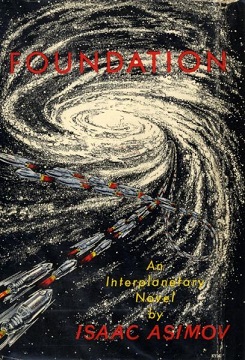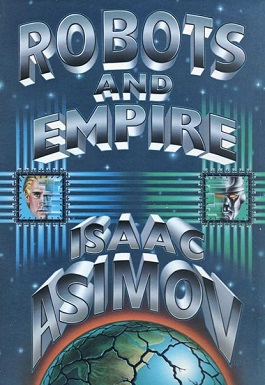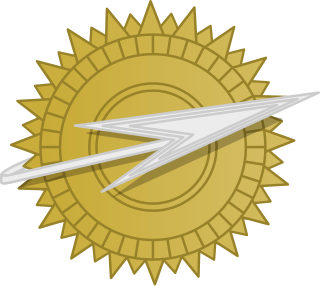
Isaac Asimov was an American writer and professor of biochemistry at Boston University. During his lifetime, Asimov was considered one of the "Big Three" science fiction writers, along with Robert A. Heinlein and Arthur C. Clarke. A prolific writer, he wrote or edited more than 500 books. He also wrote an estimated 90,000 letters and postcards. Best known for his hard science fiction, Asimov also wrote mysteries and fantasy, as well as popular science and other non-fiction.

The Foundation series is a science fiction book series written by American author Isaac Asimov. First published as a series of short stories and novellas in 1942–50, and subsequently in three collections in 1951–53, for nearly thirty years the series was a trilogy: Foundation (1951); Foundation and Empire (1952); and Second Foundation (1953). It won the one-time Hugo Award for "Best All-Time Series" in 1966. Asimov later added new volumes, with two sequels: Foundation's Edge (1982) and Foundation and Earth (1986), and two prequels: Prelude to Foundation (1988) and Forward the Foundation (1993).
The Galactic Empire series is a science fiction sequence of three of Isaac Asimov's earliest novels, and extended by one short story. They are connected by their early place in his published works and chronological placement within his overarching Foundation universe, set around the rise of Asimov's Galactic Empire, between the Robot and Foundation series to which they were linked in Asimov's later novels.

Pebble in the Sky is a science fiction novel by American writer Isaac Asimov, published in 1950. This work is his first novel — parts of the Foundation series had appeared from 1942 onwards in magazines, but Foundation was not published in book form until 1951. The original Foundation books are also a string of linked episodes, whereas this is a complete story involving a single group of characters.

Robots and Empire is a science fiction novel by the American author Isaac Asimov, published by Doubleday Books in 1985. It is part of Asimov's Robot series, which consists of many short stories and five novels.
"Blind Alley" is a science fiction short story by American writer Isaac Asimov. It was first published in the March 1945 issue of Astounding Science Fiction, and later included in the collection The Early Asimov (1972).
"Mother Earth" is a science fiction novella by American writer Isaac Asimov. It was written from September 1 to October 10, 1948, and published in the May 1949 issue of Astounding Science Fiction. It was republished in Asimov's 1972 short story collection The Early Asimov.

The Galactic Empire is an interstellar empire featured in Isaac Asimov's Robot, Galactic Empire, and Foundation series. The Empire is spread across the Milky Way galaxy and consists of almost 25 million planets settled exclusively by humans. For over 12 millennia the seat of imperial authority was located on the ecumenopolis of Trantor, whose population exceeded 40 billion, until it was sacked in the year 12,328. The official symbol of the empire is the Spaceship-and-Sun. Cleon II was the last Emperor to hold significant authority. The fall of the empire, modelled on the fall of the Roman Empire, is the subject of many of Asimov's novels.

"C-Chute" is a science fiction short story by American writer Isaac Asimov. It was first published in the October 1951 issue of Galaxy Magazine and later appeared in Asimov's collections Nightfall and Other Stories (1969) and The Best of Isaac Asimov (1973).

The Early Asimov or, Eleven Years of Trying is a 1972 collection of short stories by American writer Isaac Asimov. Each story is accompanied by commentary by the author, who gives details about his life and his literary achievements in the period in which he wrote the story, effectively amounting to a sort of autobiography for the years 1938 to 1949.

"Black Friar of the Flame" is a science fiction short story by American writer Isaac Asimov. It was first published in the Spring 1942 issue of Planet Stories and reprinted in the collection The Early Asimov (1972). "Black Friar of the Flame" was the thirteenth story written by Asimov, and was among his least favorite, though this was due more to the multiple rewrites and rejections the story suffered than to its admittedly modest intrinsic merits.
"Homo Sol" is a science fiction short story by American writer Isaac Asimov. It was first published in the September 1940 issue of Astounding Science Fiction and reprinted in the 1972 collection The Early Asimov. It deals with the proposed acceptance into a galactic federation of hominid civilizations of the hominids of newly discovered Earth.
"The Imaginary" is a science fiction short story by American writer Isaac Asimov. It first appeared in the November 1942 issue of Super Science Stories and was reprinted in the 1972 collection The Early Asimov. Following the sale of "Half-Breeds on Venus", which was a sequel to "Half-Breed", Asimov suggested to Astounding Science Fiction editor John W. Campbell that he write a sequel to the story "Homo Sol". Campbell was unenthusiastic, but agreed. Since "The Imaginary" lacked the human-alien conflict that he had liked in the earlier story, Campbell ultimately rejected it. "The Imaginary" was the twenty-first story written by Asimov, and the twenty-ninth to be published. Due to the peculiar workings of the science fiction magazine publishing industry, "The Imaginary" appeared a month after the third story in the Homo Sol Trilogy, "The Hazing".

"The Weapon Too Dreadful To Use" is a science fiction short story by American writer Isaac Asimov. It was first published in the May 1939 issue of Amazing Stories and reprinted in the August 1965 issue of Amazing and the 1972 collection The Early Asimov. "The Weapon Too Dreadful to Use" was the eleventh story written by Asimov, and the second to be published.
"Half-Breed" is a science fiction short story by American writer Isaac Asimov. It was first published in the February 1940 issue of Astonishing Stories and reprinted in the 1972 collection The Early Asimov. It was the fifteenth story written by Asimov, and the fourth to be published. At 9000 words, it was his longest published story to date.

"Heredity" is a science fiction short story by the American writer Isaac Asimov. Asimov wrote the story, his twenty-third, in August 1940 under the title "Twins". It was rejected by John W. Campbell, editor of Astounding Science Fiction, on 29 August, and accepted by Frederik Pohl on 4 September. It appeared in the April 1941 issue of Astonishing Stories under the title "Heredity" and was reprinted in the 1972 collection The Early Asimov. Heredity was the second Asimov story to receive a cover illustration.
"Death Sentence" is a science fiction short story by American writer Isaac Asimov. It was first published in the November 1943 issue of Astounding Science Fiction and reprinted in the 1972 collection The Early Asimov.
"Silly Asses" is a science fiction short story by American writer Isaac Asimov. It was published in the February 1958 issue of Future Science Fiction, after having been twice rejected by other outlets. It was subsequently included in the collections Have You Seen These? in 1974 and Buy Jupiter and Other Stories in 1975. It runs to less than two pages in paperback.
The Foundation universe is the future history of humanity's colonization of the galaxy, spanning nearly 25,000 years, created through the gradual fusion of the Robot, Galactic Empire, and Foundation book series written by American author Isaac Asimov.
Depending on the counting convention used, and including all titles, charts, and edited collections, there may be currently over 500 books in Isaac Asimov's bibliography—as well as his individual short stories, individual essays, and criticism. For his 100th, 200th, and 300th books, Asimov published Opus 100 (1969), Opus 200 (1979), and Opus 300 (1984), celebrating his writing.









